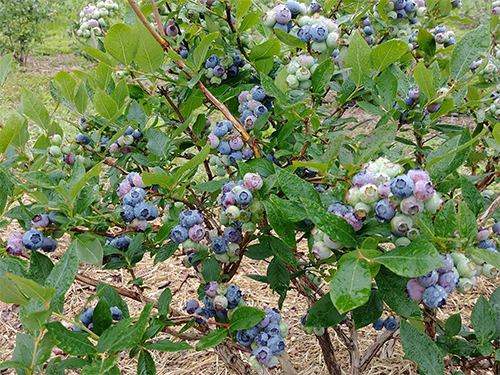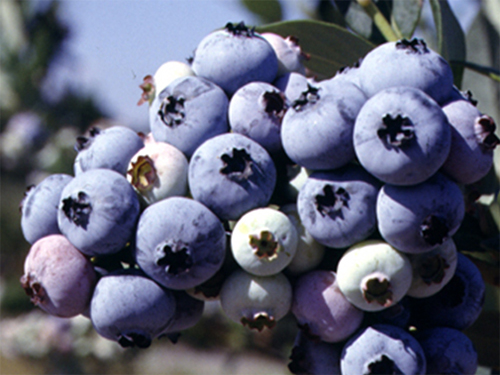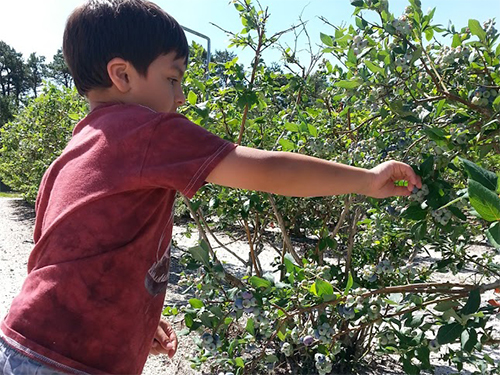
Fact Sheet FS1299
Ultra-Niche Crops are defined as exceptionally high-value crops that can provide a significant source of income to the farmer while using minimal land area.
The cultivation of the highbush blueberry is relatively new, with the first commercial crop sold in 1916. The industry of today owes its remarkable development both in the United States and worldwide to the skill and determination of breeders and growers who began selecting and breeding wild specimens of the highbush blueberry. Elizabeth C. White of Burlington County, New Jersey and Dr. Frederick Coville of the U.S. Department of Agriculture are credited with the first domestication efforts. White paid local residents to search the swamps and woodlands of South Jersey to find the best looking and tasting wild blueberry bushes in the early years of the twentieth century. See FS553, "Highbush Blueberry, The State Fruit of New Jersey", for a complete story of the beginning of the highbush blueberry industry.
Direct market sales give small acreage blueberry producers an advantage in providing ripe, high quality blueberries. Typically, blueberries that are marketed in large chain stores are not the highest quality from a flavor standpoint. Large scale growers utilize varieties that have high yields and are extremely firm, to facilitate efficient shipping and longer shelf life. Pick Your Own (PYO) growers have an advantage in the market by growing berries which are far superior in taste.
Who Will Buy the Crop?
Today's consumers have a desire to know where their food is coming from, and PYO blueberries are a perfect crop for this local food movement. Blueberries in the retail market's produce aisle are now coming from all parts of the world, so a local PYO farm affords consumers confidence in their food choices.
How Suitable Is This Crop for Agritourism?
PYO blueberries are a great addition to a farm looking to diversify their on-farm public appeal or perhaps venturing into agritourism for the first time. Consumers love blueberries and research has shown they contain high levels of antioxidants. Most people know what a ripe blueberry looks like, and since they are easy to pick, they will attract families with children to the farm. Blueberries often fit a timing niche for both the small farmer and the consumer, since they are harvested after strawberries and before peaches. The right blend of different PYO crops ripening throughout the season can keep customers coming back to the farm on a regular basis.
How Well Does This Crop Withstand Shipping and What Packaging Should Be Used?
Blueberries for fresh markets are usually kept just above the current dew points to avoid berry sweating. They are often sold in clear plastic clamshells which ship well and are accepted by consumers since they can see what they are buying.
Farmer's Tool Box
Essential Equipment/Supplies:
Crop Requirements
Soil
Blueberries perform best when planted and grown in soils with a pH range of 4.5–4.8. The optimum soil organic matter should be in the 2–5% range, and only the ammonium form of nitrogen should be used. Highbush blueberry plants are unable to uptake nitrogen in any other form. A pre-plant soil test is critical for blueberry plant success to determine pH, organic matter content, and nutrient availability (https://njaes.rutgers.edu/soil-testing-lab). Soil must be well drained. Blueberries are often hilled or planted in mounds above the existing soil grade to avoid roots sitting in standing water.
Water
Blueberries require two inches of water every 7–10 days. The water pH must be low to maintain the soil pH requirements. Trickle irrigation is the preferred method of watering.
Light
For optimum yields, a site with 8 to 10 hours of full sun is preferred.
What Is the Number of Frost-Free Days Required to Grow This Crop?
Blueberries require approximately 150 frost free days.
Is Frost Damage a Common Threat?
Yes, frost can be a problem in late April to early May during flowering. In many cases overhead sprinklers can prevent damage from frost. As the water freezes on the blueberries, latent heat is released when water goes from the liquid to the solid ice state and keeps the temperature above freezing. Crops should be irrigated until the next day until the ground warms and the temperature rises above freezing.
Timeline for Blueberries in New Jersey
Blueberries plants are usually planted in the spring after the threat of frost has lessened. Blueberries usually bloom beginning in mid-April. Fruit of the early varieties will ripen in mid-June through early July while mid-season varieties are harvested in early to mid-July, and late varieties ripen late July to early August. Following the initial planting or transplanting, blueberries are not harvested the first two years after planting, and growers normally pinch off the flowers to stimulate more root growth and establishment of the plants. Starting in the third year, the crop may be harvested.
Growing the Crop
How Are Blueberry Plants Started?
There are many nurseries selling blueberry plants. Usually a two-year rooted cutting is purchased for planting once your soil is amended and your hills or mounds are prepared.
How Is This Soil Prepared and How Is the Crop Typically Planted?
Based on the results and analysis of a soil test, pre-plant soil preparation involves adjusting the soil pH to the proper range with either the addition of sulfur to decrease the pH, or the addition of lime to increase the pH. Organic matter may need to be added to the soil, and then the soil is hilled up to make sure plants are never in standing water. Classically one gallon of peat moss/plant is incorporated into the planting hole.
What Is the Optimal Number of Plants per Acre?
When planting blueberries, the optimal spacing of 4 feet between plants and 10 feet between rows. This results in 1,088 plants per acre. Spacing can be decreased to 3 feet between plants and 9 feet between rows if necessary, but closer spacings are not recommended. The size and width of the equipment needed to manage the crop and acreage may play into determining the proper spacing for your farm.
What Is the General Care and Maintenance of the Crop During the Growing Season?
Fertilization
Usually an application of 10-10-10 fertilizer is made at bud break and again six weeks later. Specific nutrient recommendations are based on a leaf analysis which is taken in late July. Typical application rates of 10-10-10 are 100 lb/acre in the first year, increasing by 100 lb each year until a level of 600 lb/acre is reached in year six.
Diseases and Insects
Because the highbush blueberry evolved in New Jersey, there are a host of insect and disease pests to be mindful of and manage throughout the season. Despite these challenges, organic production of this crop is possible. Rutgers has detailed pest control recommendations for blueberry production in Rutgers NJAES publication E265, "2018 Commercial Blueberry Pest Control Recommendations for New Jersey".
What Is the General Care and Maintenance of the Crop During the Dormant Season?
Pruning is necessary to produce high quality fruits and maintain a healthy plant. Blueberry plants are pruned in late winter. For more information on blueberry pruning please see Rutgers NJAES fact sheet FS750, "Establishing Blueberries in the Home Garden".
How Is Harvesting Performed?
Blueberries are harvested by hand for PYO operations.
When Are Blueberries Harvested?
When individual plants are 100% blue it is time to pick. For the planting density recommended above, this usually requires a weekly harvest for 3 to 4 weeks.
Popular Varieties for PYO Blueberries
The standard varieties for commercial growers in New Jersey are 'Duke', which is early, 'Bluecrop', which is mid-season, and 'Elliott', which is late. Though the flavor of 'Duke' is mild it is very early and highly productive and should be considered by even the PYO grower. 'Bluecrop' is a very reliable variety and is also recommended. 'Elliott' is not recommended as there are many late varieties with much better taste. The best tasting varieties are 'Elizabeth', 'Darrow', and Chandler. Please see Rutgers NJAES fact sheet FS419, "Selecting Blueberry Varieties for the Home Garden" for additional variety suggestions.
Considerations for Organic Production
Weed control is a priority for all blueberry growers, but there are fewer options available for organic producers. Growers should avoid planting blueberries in plots that have established perennial weeds. Ideally weeds should be managed in one or more seasons prior to blueberry planting. In row (under and between plants in the row), weed control can be achieved using mulches such as sawdust, woodchips or a mix of the two. Weeds can be controlled in between individual rows by planting permanent sod. Tall fescues or hard fescues are recommended for the mid-Atlantic region. Sod can help stop soil erosion, maintain soil moisture levels and make for a more comfortable space for your PYO customers to walk and stand. When cultivation is utilized, care should be taken to protect the fine roots of the blueberry plants.
Insect and disease management in organic blueberry crops should consider the following practices that reduce conditions that favor diseases and insects:
Food Safety Considerations for PYO Blueberries
All fresh produce growers and workers should be trained in Good Agricultural Practices to reduce the risk of human pathogen contamination. PYO customers also need to be made aware of their role in food safety at the farm. Signage is the easiest way to inform them of your food safety expectations and how workers and visitors alike can properly follow them. Key points are:
Growers should prioritize the surfaces that are going to come into contact with the blueberries. In PYO operations this includes the picking buckets and the consumers themselves. Hand washing stations do not need to be fancy, but they do need to include running microbially safe water, soap, single use paper towels, grey water capture, and a trash can. PYO containers should be clean and safe for use — a new plastic bag insert is one way to reduce risk. A consumer food safety information sheet is linked in the resources section of this document for more detailed information.
Critical Considerations
References
Additional Information
October 2018
Copyright © 2024 Rutgers, The State University of New Jersey. All rights reserved.
For more information: njaes.rutgers.edu.
Cooperating Agencies: Rutgers, The State University of New Jersey, U.S. Department of Agriculture, and Boards of County Commissioners. Rutgers Cooperative Extension, a unit of the Rutgers New Jersey Agricultural Experiment Station, is an equal opportunity program provider and employer.



